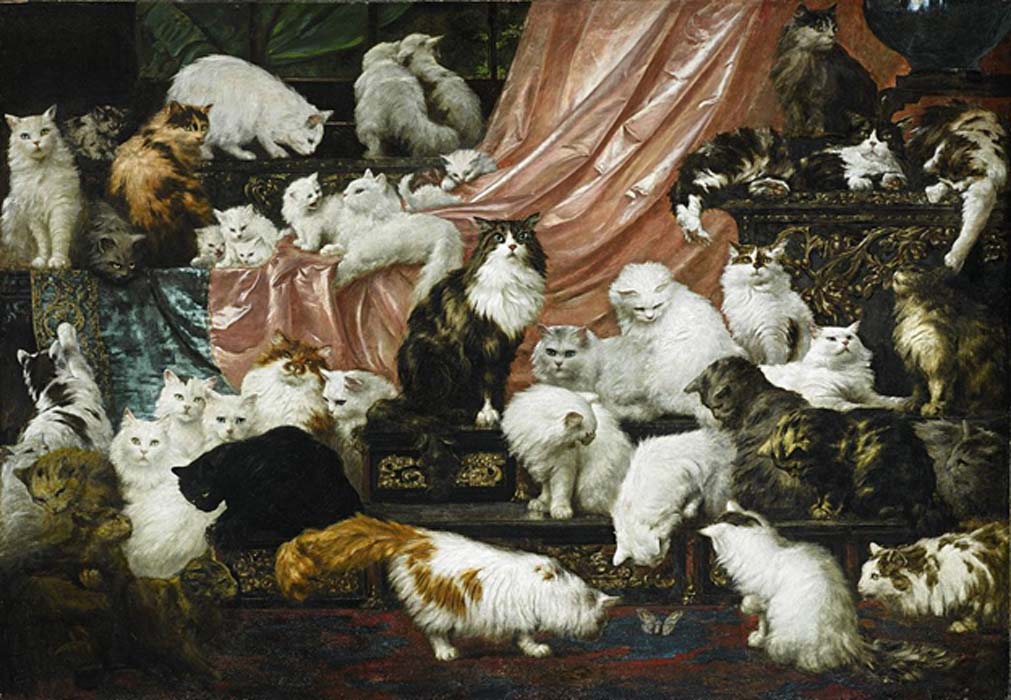DNA Analysis Suggests Cats Chose to Be Domesticated
According to an extensive DNA analysis of cat genes the domestic cat is descended from wild cats that were tamed twice; once in the Near East and then in Egypt. The study suggests that cats lived for thousands of years alongside humans before they were eventually domesticated.
From “Hunters” to Pets
Cats have traditionally been an important animal to human society as a pest-control agent, object of worship and companion animal. But in reality, we didn’t know much about its domestication process and early anthropogenic dispersal until recently. As Nature reports, after scientists used ancient DNA analysis of geographically and temporally widespread archaeological cat remains, they discovered that both the Near Eastern and Egyptian populations of Felis silvestris lybica contributed to the gene pool of the domestic cat at different historical periods.
The study reveals that farmers in the Near East were most likely the first in history to tame wild cats almost 9,000 years ago. A few thousand years later, cats would spread out of ancient Egypt along maritime trade routes, while today (and for many years now) cats live on all continents except Antarctica.
- From Mighty Bear Dogs to Breathless Bulldogs: How Human Manipulation Has Changed the Shape of Canines Forever
- Chinese May Have Loved Cats before Ancient Egyptians
- Farmers in China domesticated Asian Leopard Cats 5,000 Years Ago

Young Girl Giving Milk to Her Cat by Marguerite Gerard (Public Domain)
Scientists seem to believe that wildcats began hanging around farms in order to find food (mice attracted to grain stores) and this way the relationship between humans and felines started. "There were two taming events - one in the Near East at the beginning and one in Egypt much later. And then the cat spread very efficiently all over the ancient world as a ship's cat. Both lineages are now present in modern cats," said lead researcher Eva-Maria Geigl of Institut Jacques Monod as BBC reports.
So, it would be safe to conclude that, way before the ancient Egyptians domesticated them and later worshipped them as divine creatures, cats spent thousands of years hunting mice on ships and farms, living alongside humans, rather than being kept by them.
"I would say cats chose human company, but it was a commensal relationship - it was profitable to both sides," explained Dr Geigl as BBC reports.

Drawing on limestone of a scene from a fable, Ancient Egyptian, 19th dynasty, c1120 BC. A cat with a shepherd's crook and a bag over his shoulder guards six geese and a nest of eggs. (Public Domain)
Ancient DNA Analyses
In the study, ancient DNA analysis was performed in dedicated aDNA facilities in Paris and Leuven, France, from bone, teeth, skin and hair samples (the last two when available in Egyptian mummies) of 352 ancient cats as Nature reports. The age of the archaeological remains was determined using direct accelerator mass spectrometry (AMS) radiocarbon dating, stratigraphic associations with AMS dates, and contextual archaeological evidence. DNA was also extracted from claws and skin samples of 28 modern wildcats from Bulgaria and east Africa.
The analysis reveals when the wildcats developed into the species we see today and shows that genetically there are no major differences between wild and domestic cats.
- The Veneration and Worship of Felines in Ancient Egypt
- A Roman Era Pet Cemetery: 86 Cat Burials Discovered in Egypt
- 70 Million Mummified Animals in Egypt Reveal Dark Secret of Ancient Mummy Industry

Right, A European wildcat (F. s. silvestris) bearing a similar coat pattern to that of a tabby cat (Left). It is thought that the tabby pattern originates from the numerous subspecies of the wildcat. (CC BY SA 3.0)
Divine Cats in Ancient Egypt and Its Spread in the West
As Riley Winters reports in a previous Ancient Origins article, the first primary feline god was Mafdet, a female deity who traces back as far as the First Dynasty of Egypt between 3400 and 3000 BC. As a feline goddess, she was associated with protecting against venomous bites especially those of snakes and scorpions (probably due to the fact that cats are killers of snakes and scorpions). The more well-known goddess Bastet took Mafdet’s place as a guardian of Lower Egypt, the pharaoh, and the sun god Ra. A similar female deity with the body of a woman and the head of a cat, Bastet was considered a personification of the sun herself, with her chief shrine at the site of Bubastis in Egypt.

Bastet Nursing Kittens Kunst History Museum (CC BY SA 3.0)
From Egypt, cats would spread to Europe during the Roman era and would go even further during the Viking period. Interestingly, Egyptian cat DNA has been even found in a Viking port, revealing that cats were carried on maritime trading routes to northern Europe.
Tabby cats, however, would appear in the West only during the Middle Ages. Over the following centuries, tabby cats would spread around the world, as cats became one of the most desirable pets, thanks to their beauty. "There was very little breeding and selection going on in cats up the 19th century, in contrast with dogs. The cat was useful from the very beginning - it didn't have to be changed," Dr. Geigl tells BBC, possibly expressing (even indirectly) her preference to cats.
Top image: My Wife's Lovers is a canvas painting by Austrian artist Carl Kahler (1855-1906) depicting forty-two of American millionaires, Kate Birdsall Johnson's cats (Public Domain)




















